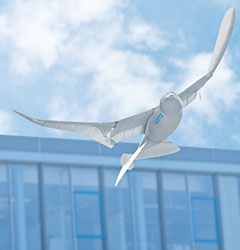Sustainability –
a benchmark for
Festo
The principle of sustainability underpins all Festo's activities and vision. Our goal: the greatest problem-solving expertise in automation technology and close, systematic partnerships with our customers. The result: business excellence in technology and didactics.
Environmental aspects of sustainability
Festo has centred its activities on sustainability and long-term value enhancement, while the conservation of resources and an orientation towards environmental protection are permanently integrated in the vision and mission of the company.
SmartBird – bird flight deciphered

Aerodynamic lightweight design
SmartBird is an ultralight but powerful flight model with excellent aerodynamic qualities and extreme agility. With SmartBird, Festo has succeeded in deciphering the flight of birds – one of the oldest dreams of humankind.
This bionic technology-bearer, which is inspired by the herring gull, can start, fly and land autonomously – with no additional drive mechanism. Its wings not only beat up and down, but also twist at specific angles. This is made possible by an active articulated torsional drive unit, which in combination with a complex control system attains an unprecedented level of efficiency in flight operation. Festo has thus succeeded for the first time in creating an energy-efficient technical adaptation of this model from nature.
New approaches in automation
The functional integration of coupled drive units yields significant ideas and insights that Festo can transfer to the development and optimisation of hybrid drive technology.
The minimal use of materials and the extremely lightweight construction pave the way for efficiency in resource and energy consumption.
Festo already today puts its expertise in the field of fluid dynamics to use in the development of the latest generations of cylinders and valves. By analysing SmartBird's flow characteristics during the course of its development, Festo has acquired additional knowledge for the optimisation of its product solutions and has learned to design even more efficiently.
AirJelly
y, the remote-controlled jellyfish AirJelly does not swim through water, but instead glides instead through a sea of air thanks to its central electric drive unit and an intelligent, adaptive mechanism. It is able to do so because it consists of a helium-filled ballonett.
AirJelly's sole source of power is two lithium-ion polymer batteries connected to the central electric drive unit. It transmits the force to a bevel gear and from there to a succession of eight spur gears, which move the eight tentacles of the jellyfish via cranks. Each tentacle is designed as a structure with Fin Ray Effect® . Propulsion of a ballonett by means of peristaltic motion is hitherto unknown in the history of aviation. AirJelly is the first indoor flight object with peristaltic drive. This new drive concept, with propulsion based on the principle of recoil, moves the jellyfish gently through the air.
AirJelly's environment is the air. Unlike AquaJell



Thank you for your interesting post. To me Festo coproration is among a unique group of companies that tackle the problem of sustainable development from many angles. They achieve very advanced results in the constant process of development and innovations and they vigorously apply the results to solve the problems of other companies in the most sustainable way. Moreover, they invest a lot of efforts in 'decoding' and 'deciphering' the sustainable models of Nature to transfer them later into Human areas. The models of machines that you posted here are a bit too complicated to use them now. However, very soon the day will surely come when the global level of technologies will allow to incorporate such kind of machines into production processes with successful financial results, and maximum efficiency levels that will be close to Nature's ones.
ReplyDelete